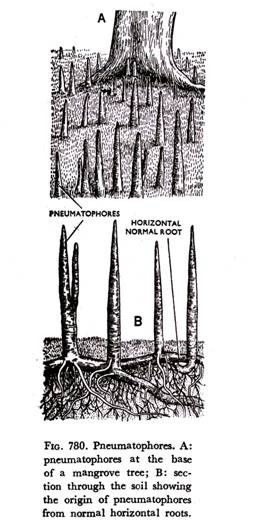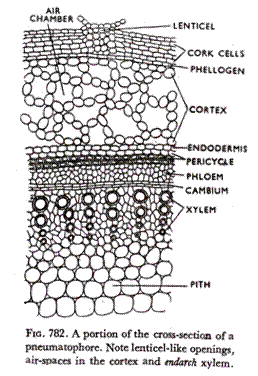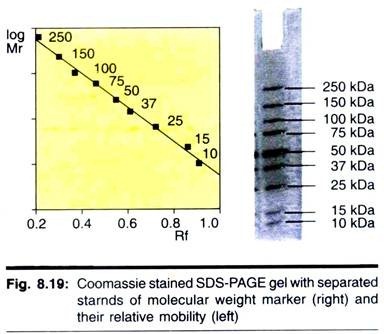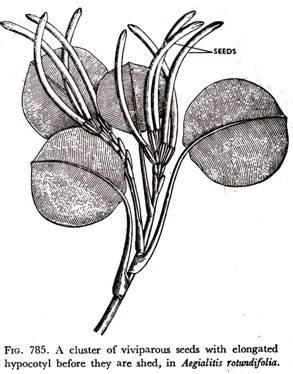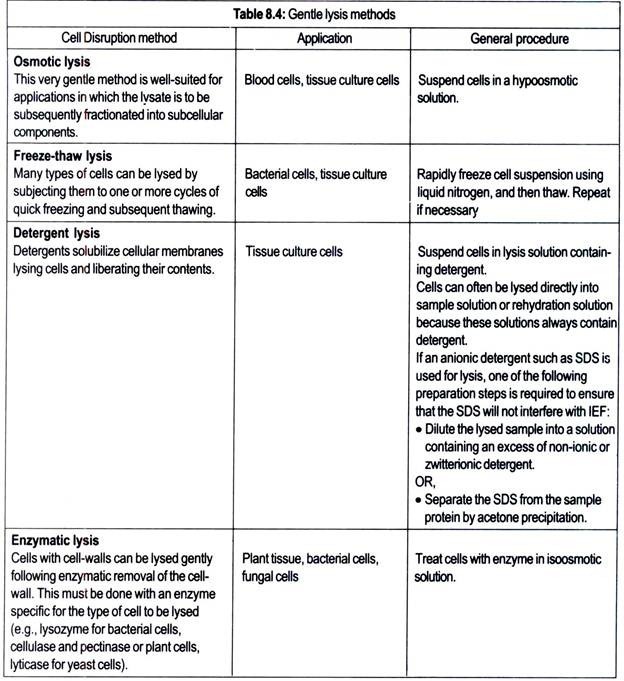ADVERTISEMENTS:
The below mentioned article provides an overview on the halophyte plants.
Halophytes:
Halophytes are plants which grow in saline soils, soils in which the concentration of simple inorganic salts is so great that only specially adaped plants such as halophytes grow naturally upon them. True halophytes are those plants that normally occur only on saline soils or in water too salty for average mesophyte.
Sugar beet and almond can be made to grow on saline soils and therefore can be called facultative halophytes. When soil contains approximately 0.5% to 1% of sodium salt, either Cl–or SO-4 ions, or more by weight of soluble salts, chemical properties of soil seem to determine its ecological character, physical differences being only by subsidiary importance.
ADVERTISEMENTS:
The action of dissolved inorganic salts on plants is partly osmotic (physical) and partly, specifically chemical, depending upon the types of kinds of ions.
If a plant cell is to maintain turgidity the concentration of osmotically active substance within the cell sap must exceed that its water supply, i.e., the concentration of the soil solution. Most non-halophytic plants (glykophytes) begin to show reduced growth when the osmotic pressure of the soil solution rises above 2 atm. Beyond this, ordinary plants have very limited ability to increase the osmotic concentration of their sap. But all halophytes possess this ability to a remarkable degree.
The osmotic pressures of halophytic cells, due to the presence of chloride ion, frequently equal 40 atm. or more (values as high as 150 atm. have been frequently reported) and as a result sometimes their tissue fluids are so impregnated with salt that they taste salty. Osmotic pressure, even as high as 200 atm., have been recorded in mangrove trees, such as Avicennia.
Sometimes in some of them (e.g., Spartina, Glaux maritina, Cressa cretica-, Frankenia sp., Limonium sp., etc.) superfluous salts are excreted by guttation through special glands. All these salt-excreting of halophytes, are sometimes referred to Crinohalophytes. Arisz et al (1955) have shown that the osmotic pressure of the exuded fluid is higher than that of cell sap, so that mediation by ATP is necessary for the removal process; oxygen is indeed necessary as the exudation process can be inhibited by respiratory inhibitors, e.g., KCN, iodoacetate, fluoride, etc.
ADVERTISEMENTS:
It is said that anthocyanin develops more and more strongly in the plants with increasing salt content, but so far as Salicornia sp. is concerned, anthocyanin development appears rather to be determined genetically. It seems that one perhaps should recognise physiological races.
Halophytes certainly take in large quantities of sodium chloride from the media to which they are adapted. In order that sodium ions in the cells may not reach toxic concentration, halophytic plants are known to adopt mechanisms for active extrusion of sodium and chloride ions. In submerged marine and brackish-water algae, sodium out-pumps have actually been located in the plasmalemna (lipid membrane bounding the cytoplasm; lipid molecules are stabilised by protein on each side) and in the chloroplasts.
The true mangrove species of Aegialitis and Avicennia are known to eliminate large quantities of sodium and potassium salts through special glands on the leaves, a property which, however, other species such as Rhizophora and Sonneratia do not seem to posses (Scholander, 1962; Eppley, 1962).
When crop plants are grown in saline soil, their root systems are generally dwarfed, transpiration is considerably reduced and there is a general tendency in the part of the plant towards water economy and conservative use of it. Because the presence of soluble inorganic salts in soil so evidently interferes with the absorption of water by non- halophytic plants, saline soils have long been considered ‘physiologically dry (Schimper, 1898), though certainly physically wet, sometimes very wet for non-halophytic plants.
Even in thirties of this century, the concept of physiological drought embraced halophytes but subsequent experimental research has shown that this old concept does not apply to them. That halophytes experience absolutely no difficulty whatsoever in absorbing water from highly concentrated salt solutions of such soils is demonstrated by their high transpiration rates (per unit leaf-area, shown in three halophytic species of Plantago), exudation of guttation water containing dissolved salts, production of shallow absorbing roots, etc.
This shows that in halophytes water absorption is considerably in excess of water loss and considering the high rates of transpiration observed in most halophytes, one of our most strongly accepted and favourite ideas is shattered. It must be admitted then that halophytes form a very interesting ecological group of plant characterised not only to endure high concentration of salts (true, certain ions only) but also to absorb water with perfect ease and composure under these adverse conditions.
Halophytic herbs grow chiefly during the rainy season owing to dilution of the soil solution and also due to the movement of salt down below the root zone. The characteristic shallow roots of any halophytes is a decided advantage in this connection and may also be an important factor from the standpoint of aeration, for saline soils frequently become water-logged during at least a part of the year.
ADVERTISEMENTS:
To counteract this lack of aeration of the root zone, many halophytes produce special negatively geotropic root branches which grow erect until they project above the poorly aerated muddy soil surface. These structures are called pneumatophores (Figs. 780, 781 and also Fig. 787).
In Carapa obovata, the pneumatophores are displayed in their simplest form—the serpentine creeping roots projecting above the mud with their upper edge, shaped like the blade of a thick knife, studded with lenticel-like pores. In the species of Bruguiera, the horizontal parent roots, here and there bend out of the mud into knee-like structures, which in Bruguiera gymnorhiza, bear large lenticels while in B. caryophylloides, lenticels are wanting due to shedding of cortex.
Avicennia officinalis, Sonneratia alba, Ceriops sp., etc., all bear negatively geotropic lateral roots, protruding from the ground like asparagus (Figs. 780 and 781). These are sometimes as long as 10 cm or as in Sonneratia, 45-50 cm. The species of Rhizophora do not possess any special pneumatophores, yet the upper parts of their descending stilt roots that are above mud, probably perform the same function.
As has been mentioned before the pneumatophore supply the underground parts of these halophytic trees with oxygen. All pneumatophores are provided with devices for absorbing oxygen from the atmosphere such as lenticel-like pores and thin cork, and also for transporting the absorbed oxygen; there are highly developed intercellular passages continuous with the stomata of the leaves in the primary cortex and also in the phloem.
ADVERTISEMENTS:
It is interesting to point out here that in their apparent anatomical structures such as collateral and endarch arrangement of the vascular bundles, mature pneumatophores resemble normal stem and not root (Fig. 782). In very young pneumatophores, however, sometimes the radial and exarch arrangements of bundles, typical of roots, can be discerned.
A large percentage of halophytic flora, e.g., Suaeda maritima, Mesembiyanthemum, Salsola kali, etc., exhibit succulence, the significance of which is obscure (Fig. 783).
Suaeda maritima may only be an aggregate species—the species will tolerate high salinities, though optimum growth takes place at about 0-95-1 ‘00% (not more) NaCl in the soil. Suaeda maritima perhaps represents a distinct variety or ecotype. The amount of sodium cloride in the tissue can be considerable and may even exceed that of Salicornia (2.5% NaCl). It is par excellence, the pioneer colonists of secondary bared areas such as pans, ditch spoil, etc.
ADVERTISEMENTS:
There is abundant seed production in this genus; a single plant of Suaeda macrocarpa producing up to 1000 seeds, but the viability of the seeds is low and it also decreases with increasing salt concentration of the medium. Dissolved salts in soil solutions especially chlorides of sodium, as pointed out before, are definitely known to stimulate succulence in many non-halophytes.
Even in halophytes, in which sodium is present in greatest quantity, it does not seem to be indispensable for them. Halophytes live in soils rich in sodium, not because they love it, but because they can tolerate it better than other plants. The greater ability to accumulate large quantities of sodium ions in their cells without any apparent ill effect, perhaps leads to their succulence which concentration would have been injurious to non-halophytes. The characteristic succulence of some halophytes may be lost, more or less completely, if grown in soil without common salt.
The salt tolerant Asparagus is more succulent when grown in saline soil (rich in sodium chloride) than in non-saline soil.
ADVERTISEMENTS:
Cryptogams are very poorly represented in the halophytic flora. Only a few moss, e.g., Pottia salina, Pottia crinita, Bryum salinum, Grimmia maritima, etc. (the single moss that grows in the sundarbans is Calymperes sundarbanense, and ferns e.g., the polypodiaceous Acrostichum aureum and Ceratopteris thalictroides, perhaps the only ferns which occur in number in the Gangetic estuarine Bengal and Drymoglossum carnosum, with succulent more than overcome this difficulty by some physiological adaptation for in many such plants, the presence of certain minimum concentration of salt is much more favourable for germination and seedling-survival than its absence. Consequently successful germination of halophytic seeds is usually restricted to rainy seasons when the salt solution is more dilute.
A number of halophytes of sea coasts or other saline soil bordering the seas, in the deltas and estuaries, has developed a peculiar type of germination known as vivipary, which is defined as germination of seeds before the fruits break off from the plant (Fig. 784). The large embryo, without endosperm, grows and develops in the seed within the fruit when it is still attached to the plant.
In Rhizophora mucronata the fruit which is leathery and indehiscent, soon after the completion of its growth, it pierced at its summit by the green hypocotyl, as the embryo does not require any period of rest, continuing its development without interruption.
The hypocotyl is club-chaped and attains a length of 50-75 cm (sometimes even a metre) before it falls down, leaving behind the fused cotyledons which served as absorbing organs of the developing seedling. As the lower end of the hypocotyl is thicker, the embryo seedling falls vertically with its root-tip downwards into the soft saline mud and within a few hours develops lateral roots that fix the seedling firmly.
Sometimes, if the water level be high, the embryo floats with the hypocotyl (radicle) downwards and waits for a good chance of catching a suitable crack in the soft mud as the water level falls. Vivipary is also exhibited by Aegiceras majus, Aegialitis rotundifolia, Kandellia reedi, Ceriops sp. and Brugiera sp. An incipient type of vivipary is also seen in Avicennia sp.
Some interesting cases in the relationship of vivipary and non- vivipary is exhibited by certain halophytic plants; for example some typical non-viviparous plants in their native habitats, e.g., Sweden and Finland, when transplanted to California become viviparous. It was presumed that photo- period was a controlling factor in the development of vivipary. Similarly, it was found that viviparous plants, e.g., Poa alpina, from eastern Greenland, within a short time turned non-viviparous when grown in Zurich (Switzerland).
All these seem to confirm the fact that both light duration and intensity are important factors in controlling vivipary.
A distinctive viviparous germination of seeds is seen in Aegialitis rotundifolia, a striking and widely occurring mangrove in the Sunderban region of West Bengal. Beautiful, green clusters (about 15-20) of viviparous seeds slightly curved at the top (7-8 cm long) are seen in a cymose umbellate type of arrangement (Fig. 785) all pointing upwards. When dry, the green outer-skin of the thickened hypocotyl is seen to rupture in five longitudinal strips, leaving a solid central core behind.
The embryo-seedlings of Aegiceros are curved like horns and remain enclosed in the thin pericarp of the fruit and are in general shorter than those of the Rhizophoraceae. Those of Avicennia, which sometimes fall still surrounded by the leathery pericarps that dehisce subsequently, and at other times without the pericarp, are provided with bent and densely hairy hypocotyl attached to two large cotyledons.
The hairs are stiff and curve upwards and fix the seedling to the mud. In the remaining mangrove plants, vivipary does not occur but the embryo-seedlings of some species, particularly those of Acanthus ilicifolius, a thistle-like herb, are always further developed in the fruit than in non-halophytes.
The phenomenon of vivipary can be looked upon as an adaptation by which the retarding influence of high salt concentration on seed germination is conveniently avoided by some halophytic plants.
ADVERTISEMENTS:
A littoral bluish-green species of Graminae, Spinifex squarrosus (the other 4 species of Spinifex are all Australian desert xerophytes) growing in sandy saline seashores of peninsular India, particularly in Andhra sea coasts and further down south has an interesting type of fruit dispersal.
This dioecious plant with female spikelets massed together in globular inflorescence and in- fructescence (which latter appears to be composed of long radially arranged stiff, spiny bracts) has creeping shoots which are firmly anchored in the loose shifting saline substratum of the sea coasts by numerous deeply penetrating roots.
The plant is thus in much less danger of being torn out by wind. The spherical infructescence (Fig. 786) formed by stiff, bracteate bristles, when ripe breaks off from its dry stalk and becomes the plaything of the wind. Dancing and somersaulting, the infructescence is hurried along the smooth surface of the sand dropping its fruits on its trail. The bristles are gradually worn away and the infructescence gets finally stuck in the sand and buried with the rest of the fruits.
It is true that the effects of concentration of salts are largely osmotic in nature but the carbonates of sodium and potassium seem to have special physiological effects which are not found with other salts or ions. Each of the salt responsible for the salinity of soil seems to have certain specific effects upon plants.
Some halophytes, particularly halophytic annuals, may be completely lacking in any special regulatory mechanism for their survival, except of course, the increase in the osmotic pressure of the cells in leaves which gradually rises to a maximum, at which point (end of the season) the leaves die. In these plants, chloride content of their root cells is regarded as rising to lethal values at the end of vegetative period or during long dry periods.
It has been suggested by Kursanov (1956) that the increase in salinity of the medium, may alter or determine the occurrence of sex in plants. In dioecious species, salinity may sometimes be responsible for an increase in staminate flowers.
In halophytes growing in northern latitudes, incidence of polyploidy was found to be significantly higher. It may be that polyploidy in these plants is associated with tolerance of extreme climatic and edaphic conditions.
Mycorrhizas, mostly endophytic types, are sometimes associated with plants adapted to saline soils—only the smallest roots are infected and the fungus seems to be restricted to a specific zone of the cortex.
Mangroves:
A special halophytic vegetation represented by the well-known mangrove formations, some of them typically Indian (Eastern Asia) are found on the saline soils of the Gangetic estuarine deltas near the Bay of Bengal—the Sunderban areas, in Western India near the sea coasts of Bombay and Kerala (barely a mile in width) and in the banks and creeks of the Gautami Godavari in South India where the river meets the sea. The mangrove forests are highly developed in both the Andaman and Nicobar Islands (21 sp. in about 1200 sq. km).
In the Andamans they form a distinctive feature on the borders and river estuaries and lagoons. These luxuriant mangroves are really the guardians and builders of the Andamans for the seaward growing forests of mangroves, spreading roots into the shallow water, hold the mud and the sand together, which otherwise would have been washed down the rivers. All these regions are continually washed by tidal rivers and as a result the saline soil everywhere is sandy, loose and swampy.
Such water logging by saline water, relatively high rainfall, high humidity, more or less equable temperature and complete absence of ground frost are some of the essential conditions necessary for the development of mangroves. Dense and frequently repeated cloudiness apparently is also an important climatic factor for the occurrence of mangroves in the tropics. During the recent years the mangrove forests have undergone considerable modifications in various regions due to biotic influences, i.e., man- made activities.
The typical Indian true mangrove flora comprises about 20 species of flowering plants belonging to about 10 genera.
The characteristic adaptive features of these mangroves can be summarised as follows:
(1) Production of respiratory roots, pneumatophores for efficient aeration—the soil is water-logged and the aeration in the root medium is consequently much below optimal (Figs. 780-782 and also Fig. 787);
(2) Formation of stilt-like prop roots arising from the main trunk of the trees for efficient anchorage of plants in the loose sandy soil where fixation by the shallow ordinary roots is often difficult.
The stilt roots which give Rhizophora mucronata such a peculiar appearance are relatively strongly developed in the herbaceous Acanthus ilicifolius and to a lesser extent in Rhizophora conjugata. In the other mangrove trees they are either absent or only very slightly developed, particularly those stilt roots descending from the branches.
Sometimes a large number of aerial adventitious roots, flying buttress, are developed and these combined with pneumatophores, stilt roots, knee roots and sometimes, plank buttresses (these structures are not true roots but are outgrowths of roots and stems which may or may not have a continuous development.
They are all more or less triangular and may extend up the trunk to 75 cm or more; others may be comparatively low but extend laterally from the base for about 50 cm or even over. Buttresses, when present, add strength to the shallow-rooted trees) may make a mangrove forest an impenetrable tangle of roots;
(3) Viviparous method of germination of seeds;
(4) Plants are generally shrubs; herbs are somewhat rare, except perhaps, Acanthus ilicifolius, Heliotropium ovalifolium, etc. Some shrubby species become dome-shaped be repeated cymose branching;
(5) Succulence of stem is a common characteistic. Leaves are xerophilous, generally small in size, thick and are very often glossy. There are also thick cuticles, large mucilage cells, protected stomata but never truly sunken and sometimes large-celled thin-walled aqueous tissue. Sometimes old leaves serve as water reservoirs for younger leaves (e.g., R. mucronata). These adaptations certainly seem xeromorphic in nature.
But why xeromorphy in halophytes? We know that as regards availability and absorption of water these plants live in conditions of luxury. Thus xeromorphy in halophytes is apparently an example of purposeless adaptation and, as has been pointed out before, is only a remainder of their xerophytic ancestry. The halophytic sp. of Spartina which grows abundantly on the eastern sea coasts of England is definitely known to be derived from two parental forms which are themselves not halophytic at all.
The mangrove flora of Gangetic W. Bengal shows different varieties of life forms correlated with substrata. They belong to several different families but present many points of similarity in their adaptations. Most of them are very much isolated in their systematic position and consequently appear to be very old associations.
Recent determination of chromosome numbers of a few mangroves (Ceriops, Sonneratia, Avicennia, etc.) may throw interesting light on the taxonomic positions of the mangroves. Names of a few species, classified according to the soil substrata in which they grow are given here.
Some of them are really non-mangroves but are seen in association with mangrove plants at various levels. The mangrove communities in these regions, as in all others, are primarily edaphic in nature and can be classed as edaphic climaxes.
These mangroves generally develop in sheltered tidal areas where the alluvial substratum is subjected to periodic flooding:
Open sea—planktonic algae.
Deep sea bottom—hold-fast fixed benthic algae.
Terrestrial but not submerged.
Sandy soils of river estuaries:
Prostrate succulent herbs or shrubs—Suaeda maritima (Chenopodiaceae); Mesembryanthemum (Ficoideae); Abronia martima (Nyctaginaceae); the last two are not common in the Gangetic estuary.
Shrubs—Ceriops roxburghiana (Rhizophoraceae).
Heavier soils: sandy soils mixed with river silt and humus:
Tall, evergreen shrubs or low trees:
Avicennia alba (Verbenaceae); Rhizophora nucronata, Rhizophora conjugata, Bruguiera gymnorhiza (all Rhizophoraceae). Rhizophoraceae may have originated from Theaceae or even Tiliaceae. Aegiceras majus (Myrsinaceae); Sonneratia apetala (Sonneratiaceae), Heritiera sp., macrophylla, minor, etc., (Sterculiaceae). The Rhodophytan alga, Coelarlhrum sp. (Sphaeroccocaceae) epiphytic on the mangrove tree trunks and also on pneumatophores are plentiful in these regions.
These algae are completely submerged at high tides, getting exposed, however, when the tide is low. The moss Calymperes sundarbanense is an epiphyte growing just at the tidal level.
An interesting point to note here is that almost all large and small fishes around these regions do have enormous masses of this Coelarthrum in their alimentary canal; these red algae look like making nutritive food for fishes. Is it possible that these insignificant algae around here may be rich in protein content? Certainly, an examination of their total nitrogen content—inorganic and organic—is called for.
Succulent herbs, shrubs or evergreen small trees:
The succulent fern, Ceratopteris thalictroides (Parkeriaceae); Excoecaria agallocha (Euphorbiaceae). All Excoecaria sp. of Sunderban region seem to harbour a hemiparasitic species of Loranthus articulata. The host parasite relationship is very strong for all Excoecaria sp., so far examined are found to have the green Loranthus on them.
The parasitic selection of host seems specific indeed and certainly points to an intimate physiological relationship between them. Sesuvium portulacastrum (Ficoideae), the succulent twiner, Basella rubra (Chenopodiaceae), Salicornia brachiata{ Chenopodiaceae), etc. In some species of Salicornia, they are capable of absorbing water directly through cuticle when they are flooded by the tide; indeed as much as 60% or more of water lost in the preceding exposed period can be reabsorbed in a comparable period of submergence.
Low, non-succulent perennial herbs or shrubs:
Acanthus ilicifolius (Acanthaceae); Aegialitis rotundifolia (Plumbaginaceae); Carapa obovata (Meliaceae); the saline palms, Nipa fruticans and Phoenix paludosa (both Palmae); the polypodiaceous fern, Acrostichum aureum.
Grasses:
Truly salt-tolerant Oryza sativa, var Patnai, Achra, etc., and the wild rice species of Oryza coarctata; Myriostachya (Graminaceae); Scirpodendron (Cryperaceae).
A number of succulent species of the order Chenopodiales, growing abundandy in saline soil, has been grouped under a special family—Halophytaceae (Hutchinson, 1946).
In addition to the soils in which sodium chloride is predominant there are other soils with much Na2SO4 and Na2CO3. They carry a special flora, and the species and zonations are different from those of true mangroves in NaCl- soil. In-the waters of these “soda lakes”, species of Enteromorpha, Spirogyra, Zannichellia, etc., flourish.
Prain divided mangroves of Sunderban region localised into three plant geographical zones:
(1) Southern coastal strip and the south-western part,
(2) The central zone of Heritiera and
(3) The north-eastern part.
Other regional divisions may be:
(i) The fresh-water forests,
(ii) The moderately salt-water forests and
(iii) The salt-water forests.
Ceriops forms pure forest on higher grounds near the sea, one of the dominant species of the Sunderban region.
The stages in ecological plant successions in the formation of mangrove forests in the Sunderban region may be of two different progression types—one starting from the sand dune and the other conceivably from a saline swamp, both progressions ending up with the same climax forest of Heritiera fomes.
The zonations of mangroves from sea-water to inland in South-Eastern Asia may be:
(1) Avicennia, Sonneratia type;
(2) Bruguiera caryophylloides type;
(3) Rhizophora type;
(4) Bruguiera parviflora type and
(5) Bruguiera gymnorhiza type.
Similar zonal distribution is also likely to be met in the Sunderban region. This frequency and distribution of mangroves species are undoubtedly correlated with the degree of salinity of the soil— the salinity evidently gradually decreasing from the sea-water line to landward side.
The mangrove species of the western sea coasts of India are not as rich compared to the mangroves of Ganges estuary, both in distribution and in density.
The six communities which are common in the western sea coasts are:
(i) Avicennia alba, Avicennia officinalis,
(ii) Avicennia alba, Acanthus ilicifolius,
(iii) Sesuvium portulacastrum,
(iv) Suaeda fruticosa,
(v) Aleuropus repens and
(vi) Salvadora sp.
The mangroves of Salsette islands near Bombay contain a few characteristic species such as Ceriops tagal (Rhizophoraceae).
The ecological succession of plants in mangrove forests in western coasts in India may be, from the pioneer species of mangroves of swampy regions, e.g., Rhizophora, Acanthus, Ceriops, Bruguiera, Sonneratia, etc., followed in succession by tidal mangroves, e.g., Avicennia, Suaeda, etc., then by non-littoral mangrove species, e.g., Thespesia, and Tamarix and finally colonisation is completed by xerophilous non-mangroves.
The mangrove vegetation of the Godavari delta in Andhra (South India) is rich and the pioneer species of the muddy flat regions, constituting about 75% of the mangrove forest flora are Avicennia alba and Avicennia marina, the last one seems to be one of the characteristic mangrove species of these regions. Further inland, Rhizophora, Bruguiera, Ceriops and Sonneratia and still further to it, Acanthus ilicifolius, Myrxostachya wightiana, Clerodendron inerme, etc., form dense thickets.
On the landward higher land, true mangroves seem to disappear, their place being taken by almost pure crops of Aegiceras and Excoecaria, growing side by side with really non-mangrove dimbers such as Dalbergia spinosa, Denis uliginosa and Sarcobolus carinatus.
Communities of plants, common on the saline soil of Pondicherry sea coasts are distinctive in their features. A few species, cited here, are specific for these regions and are not usually found in the Sunderban delta, e.g., two Suaeda species, Suaeda nudiflora and Suaeda monoica. Among the interesting trees are Salvadora persiea. Other common species in the saline marshes and of coastal sands are Cressa cretica, Aeluropus lagopoides, Heliotropium curassavicum, etc. A Spinifex species, Spinifex littoreus is abundantly found on the seashore and on the newer sand dunes.
ADVERTISEMENTS:
The composition of any mangrove vegetation undergoes changes with the gradual elevation of the land from the sea-level. The vegetation is thus truly transitory in nature.
The succession of vegetation on a virgin land arising from the sea-level consists of:
(i) Pure crops of pioneering true mangroves such as Avicennia, followed by
(ii) Other mangrove species such as Rhizophora, Bruguiera, Ceriops, etc., forming the so-called mixed mangrove forests. As the ground rises above the spring high-tide level, the true mangroves disappear, followed by
(iii) Invasion and colonisation of such lands by halophytic plants such as species of Excoecaria, Aegiceras, etc. which are specially adapted to such saline soils forming climax forest. The Excoecaria, etc., forests are interspersed with
(iv) Extensive barren lands with no other important vegetation except perhaps the succulent and prostrate, Suaeda maritima. Finally
(v) The salt-tolerant grasses arrive, colonise and fully stabilise themselves in the area and ultimately make the land fit for cultivation of cereals like varieties of paddy such as the salt-enduring Oryza saliva, var Patnai, Achra, etc. (A hybrid selection from the two has been raised and found to be highly salt- tolerant). The evolution and decline of a mangrove forest are thus completed.
It may be of interest to point out here that high saline soils are not necessarily restricted to sea or ocean coasts only. In many regions such as in certain parts of the arid Rajasthan and other deserts of India, far away from any sea coasts, the soil is distinctly saline due to the presence of salts like NaCl, CaSO4, Na2CO3, etc. particularly NaCl. The range of pH in these soils varies from near neutral (7- 5) to appreciably alkaline (9-5).
The origin of high salinity of these soils is not quite dear, but may be due to:
(i) Weathering of rocks,
(ii) Salts brought by wind from neighbouring salt concentrations and;
(iii) Regional leaching and concentrations.
A characteristic halophytic vegetation, beautifully adapted to both high salinity and water scarcity conditions, represented among others by following species which seem to thrive well in these regions:
Tamarix dioica, Tamarix articulata, Chenopodium album, Artiplex cressifolia, Suaeda fruticosa, Haloxylon salicorneum, Haloxylon multiflorum, Salsola foetida, etc.
These communities of desert halophytes can very appropriately be described as microedaphic formations.
